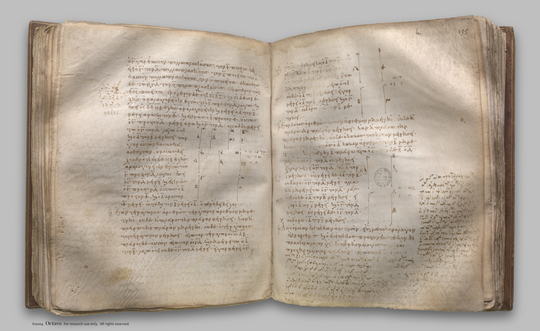index prev next | digilib folio 159

Between two similar plane numbers there is one mean proportional number; and the plane number has to the plane number the ratio duplicate of that which the corresponding side has to the corresponding side.
| Δύο ὁμοίων ἐπιπέδων ἀριθμῶν εἷς μέσος ἀνάλογόν ἐστιν ἀριθμός: καὶ ὁ ἐπίπεδος πρὸς τὸν ἐπίπεδον διπλασίονα λόγον ἔχει ἤπερ ἡ ὁμόλογος πλευρὰ πρὸς τὴν ὁμόλογον πλευράν. Ἔστωσαν δύο ὅμοιοι ἐπίπεδοι ἀριθμοὶ οἱ Α, Β, καὶ τοῦ μὲν Α πλευραὶ ἔστωσαν οἱ Γ, Δ ἀριθμοί, τοῦ δὲ Β οἱ Ε, Ζ. καὶ ἐπεὶ ὅμοιοι ἐπίπεδοί εἰσιν οἱ ἀνάλογον ἔχοντες τὰς πλευράς, ἔστιν ἄρα ὡς ὁ Γ πρὸς τὸν Δ, οὕτως ὁ Ε πρὸς τὸν Ζ. λέγω οὖν, ὅτι τῶν Α, Β εἷς μέσος ἀνάλογόν ἐστιν ἀριθμός, καὶ ὁ Α πρὸς τὸν Β διπλασίονα λόγον ἔχει ἤπερ ὁ Γ πρὸς τὸν Ε ἢ ὁ Δ πρὸς τὸν Ζ, τουτέστιν ἤπερ ἡ ὁμόλογος πλευρὰ πρὸς τὴν ὁμόλογον [ πλευράν ]. Καὶ ἐπεί ἐστιν ὡς ὁ Γ πρὸς τὸν Δ, οὕτως ὁ Ε πρὸς τὸν Ζ, ἐναλλὰξ ἄρα ἐστὶν ὡς ὁ Γ πρὸς τὸν Ε, ὁ Δ πρὸς τὸν Ζ. καὶ ἐπεὶ ἐπίπεδός ἐστιν ὁ Α, πλευραὶ δὲ αὐτοῦ οἱ Γ, Δ, ὁ Δ ἄρα τὸν Γ πολλαπλασιάσας τὸν Α πεποίηκεν. διὰ τὰ αὐτὰ δὴ καὶ ὁ Ε τὸν Ζ πολλαπλασιάσας τὸν Β πεποίηκεν. ὁ Δ δὴ τὸν Ε πολλαπλασιάσας τὸν Η ποιείτω. καὶ ἐπεὶ ὁ Δ τὸν μὲν Γ πολλαπλασιάσας τὸν Α πεποίηκεν, τὸν δὲ Ε πολλαπλασιάσας τὸν Η πεποίηκεν, ἔστιν ἄρα ὡς ὁ Γ πρὸς τὸν Ε, οὕτως ὁ Α πρὸς τὸν Η. ἀλλ' ὡς ὁ Γ πρὸς τὸν Ε, [ οὕτως ] ὁ Δ πρὸς τὸν Ζ: καὶ ὡς ἄρα ὁ Δ πρὸς τὸν Ζ, οὕτως ὁ Α πρὸς τὸν Η. πάλιν, ἐπεὶ ὁ Ε τὸν μὲν Δ πολλαπλασιάσας τὸν Η πεποίηκεν, τὸν δὲ Ζ πολλαπλασιάσας τὸν Β πεποίηκεν, ἔστιν ἄρα ὡς ὁ Δ πρὸς τὸν Ζ, οὕτως ὁ Η πρὸς τὸν Β. ἐδείχθη δὲ καὶ ὡς ὁ Δ πρὸς τὸν Ζ, οὕτως ὁ Α πρὸς τὸν Η: καὶ ὡς ἄρα ὁ Α πρὸς τὸν Η, οὕτως ὁ Η πρὸς τὸν Β. οἱ Α, Η, Β ἄρα ἑξῆς ἀνάλογόν εἰσιν. τῶν Α, Β ἄρα εἷς μέσος ἀνάλογόν ἐστιν ἀριθμός. Λέγω δή, ὅτι καὶ ὁ Α πρὸς τὸν Β διπλασίονα λόγον ἔχει ἤπερ ἡ ὁμόλογος πλευρὰ πρὸς τὴν ὁμόλογον πλευράν, τουτέστιν ἤπερ ὁ Γ πρὸς τὸν Ε ἢ ὁ Δ πρὸς τὸν Ζ. ἐπεὶ γὰρ οἱ Α, Η, Β ἑξῆς ἀνάλογόν εἰσιν, ὁ Α πρὸς τὸν Β διπλασίονα λόγον ἔχει ἤπερ πρὸς τὸν Η. καί ἐστιν ὡς ὁ Α πρὸς τὸν Η, οὕτως ὅ τε Γ πρὸς τὸν Ε καὶ ὁ Δ πρὸς τὸν Ζ. καὶ ὁ Α ἄρα πρὸς τὸν Β διπλασίονα λόγον ἔχει ἤπερ ὁ Γ πρὸς τὸν Ε ἢ ὁ Δ πρὸς τὸν Ζ: ὅπερ ἔδει δεῖξαι. | Between two similar plane numbers there is one mean proportional number; and the plane number has to the plane number the ratio duplicate of that which the corresponding side has to the corresponding side. Let A, B be two similar plane numbers, and let the numbers C, D be the sides of A, and E, F of B. Now, since similar plane numbers are those which have their sides proportional, [VII. Def. 21] therefore, as C is to D, so is E to F. I say then that between A, B there is one mean proportional number, and A has to B the ratio duplicate of that which C has to E, or D to F, that is, of that which the corresponding side has to the corresponding side. Now since, as C is to D, so is E to F, therefore, alternately, as C is to E, so is D to F. [VII. 13] And, since A is plane, and C, D are its sides, therefore D by multiplying C has made A. For the same reason also E by multiplying F has made B. Now let D by multiplying E make G. Then, since D by multiplying C has made A, and by multiplying E has made G, therefore, as C is to E, so is A to G. [VII. 17] But, as C is to E, so is D to F; therefore also, as D is to F, so is A to G. Again, since E by multiplying D has made G, and by multiplying F has made B, therefore, as D is to F, so is G to B. [VII. 17] But it was also proved that, as D is to F, so is A to G; therefore also, as A is to G, so is G to B. Therefore A, G, B are in continued proportion. Therefore between A, B there is one mean proportional number. I say next that A also has to B the ratio duplicate of that which the corresponding side has to the corresponding side, that is, of that which C has to E or D to F. For, since A, G, B are in continued proportion, A has to B the ratio duplicate of that which it has to G. [V. Def. 9] And, as A is to G, so is C to E, and so is D to F. |